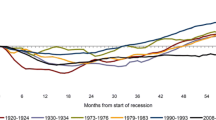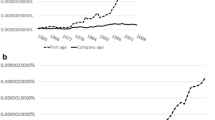Abstract
Does size matter for new firms and do they need to be large to be profitable? From small to large firms, a wide range of arguments have explored the possible strengths and liabilities associated with size. Despite the long interest in the relation between size and profitability, the empirical evidence is mixed and inconclusive. To date, studies focus mainly on established firms. In order to advance the knowledge on the relation, we examine the effects of size on the profitability of newly established firms in their first years of business. Overall, the results show that size has a positive impact on the profitability of new firms. In particular, increases in the number of employees have a positive effect on the return on assets that indicates that being small is a liability for new firms. Further, this finding indicates the need for a certain critical mass of employees when firms start out. By starting out with a higher number of employees, new firms may invest in the development of their performance by stimulating learning and motivation and, in this way, increase their profitability and their chances of survival. In addition to the liability of smallness, we also investigate the moderator effect of age. Our conclusions support the liabilities of obsolescence and senescence arguments that state that as firms age, they have difficulties in adapting to the external environment and face internal inertia.
Similar content being viewed by others
References
Amato, L. (1995). The choice of structure measure in industrial economics. Quarterly Journal of Business and Economics, 34(2), 39–52.
Amato, L. J., & Amato, C. H. (2004). Firm size, strategic advantage, and profit rates in US retailing. Journal of Retailing and Consumer Services, 11(3), 181–193.
Ambrose, B. W., Fuerst, F., Mansley, N., & Wang, Z. (2019). Size effects and economies of scale in European real estate companies. Global Finance Journal, 42, 100470.
Anyadike-Danes, M., Bjuggren, C. M., Gottschalk, S., Hölzl, W., Johansson, D., Maliranta, M., & Myrann, A. (2015a). An international cohort comparison of size effects on job growth. Small Business Economics, 44(4), 821–844.
Anyadike-Danes, M., Hart, M., & Du, J. (2015b). Firm dynamics and job creation in the United Kingdom: 1998–2013. International Small Business Journal, 33(1), 12–27.
Arend, R. J. (2014). Entrepreneurship and dynamic capabilities: How firm age and size affect the ‘capability enhancement–SME performance’ relationship. Small Business Economics, 42(1), 33–57.
Bamiatzi, V., & Hall, G. (2009). Firm versus sector effects on profitability and growth: The importance of size and interaction. International Journal of the Economics of Business, 16(2), 205–220.
Bamiatzi, V., Bozos, K., Cavusgil, S. T., & Hult, G. T. M. (2016). Revisiting the firm, industry, and country effects on profitability under recessionary and expansion periods: A multilevel analysis. Strategic Management Journal, 37(7), 1448–1471.
Barney, J. (1991). Firm resources and sustained competitive advantage. Journal of Management, 17(1), 99–120.
Barney, J. B., Ketchen Jr., D. J., & Wright, M. (2011). The future of resource-based theory: Revitalization or decline? Journal of Management, 37(5), 1299–1315.
Barron, D. N., West, E., & Hannan, M. T. (1994). A time to grow and a time to die: Growth and mortality of credit unions in New York City, 1914-1990. American Journal of Sociology, 100(2), 381–421.
Becker-Blease, J., Kaen, F., Eterabi, A., & Baumann, H. (2010). Employees, firm size and profitability in U.S. manufacturing industries. Investment Management and Financial Innovations, 7(2), 119–132.
Berk, J., & DeMarzo, P. (2014). Corporate finance, 3rd Ed. Boston: Pearson.
Burgelman, R. A. (1991). Intraorganizational ecology of strategy making and organizational adaptation: Theory and field research. Organization Science, 2(3), 239–262.
Burja, C. (2011). Factors influencing the companies’ profitability. Annales Universitatis Apulensis Series Oeconomica, 13(2), 215–224.
Canbäck, S., Samouel, P., & Price, D. (2006). Do diseconomies of scale impact firm size and performance? A theoretical and empirical overview. Journal of Managerial Economics, 4(1), 27–70.
Chrisman, J., Bauerschmidt, A., & Hofer, C. (1998). The determinants of new venture performance: An extended model. Entrepreneurship Theory and Practice, 23(1), 5–29.
Coad, A., Segarra, A., & Teruel, M. (2013). Like milk or wine: Does firm performance improve with age? Structural Change and Economic Dynamics, 24, 173–189.
Coad, A., Segarra, A., & Teruel, M. (2016). Innovation and firm growth: Does firm age play a role? Research Policy, 45(2), 387–400.
Coad, A., Holm, J. R., Krafft, J., & Quatraro, F. (2018). Firm age and performance. Journal of Evolutionary Economics, 28(1), 1–11.
Dhawan, R. (2001). Firm size and productivity differential: Theory and evidence from a panel of US firms. Journal of Economic Behavior & Organization, 44(3), 269–293.
Eurostat (2008). NACE Rev. 2: Statistical classification of economic activities in the European Community. https://ec.europa.eu/eurostat/documents/3859598/5902521/KS-RA-07-015-EN.PDF. Accessed: 15 August 2019.
Eurostat (2020). Business demography main derived indicators - NACE Rev. 2 (B-N excluding K64.2) [TIN00142]. https://ec.europa.eu/eurostat/product?code=BD_9BD_SZ_CL_R2&mode=view. Accessed: 11 July 2020.
Fairfield, P., & Yohn, T. (2001). Using asset turnover and profit margin to forecast changes in profitability. Review of Accounting Studies, 6(4), 371–385.
Fernández, E., Iglesias-Antelo, S., López-López, V., Rodríguez-Rey, M., & Fernandez-Jardon, C. M. (2019). Firm and industry effects on small, medium-sized and large firms’ performance. Business Research Quarterly, 22(1), 25–35.
Hall, M., & Weiss, L. (1967). Firm size and profitability. The Review of Economics and Statistics, 49(3), 319–331.
Hannan, M. T. (1998). Rethinking age dependence in organizational mortality: Logical formalizations. American Journal of Sociology, 104(1), 126–164.
Ilaboya, O., & Ohiokha, I. (2016). Firm age, size and profitability dynamics: A test of learning by doing and structural inertia hypotheses. Business and Management Research, 5(1), 29–39.
Jeng, D. J. F., & Pak, A. (2016). The variable effects of dynamic capability by firm size: The interaction of innovation and marketing capabilities in competitive industries. International Entrepreneurship and Management Journal, 12(1), 115–130.
Jensen, M., & Meckling, W. (1976). Theory of the firm: Managerial behavior, agency costs and ownership structure. Journal of Financial Economics, 3(4), 305–360.
Jónsson, B. (2007). Does the size matter? The relationship between size and profitability of Icelandic firms. Bifröst Journal of Social Science, 1(1), 43–55.
Kale, S., & Arditi, D. (1998). Business failures: Liabilities of newness, adolescence, and smallness. Journal of Construction Engineering and Management, 124(6), 458–464.
Kipesha, M. (2013). Impact of size and age on firm performance: Evidences from microfinance institutions in Tanzania. Research Journal of Finance and Accounting, 4(5), 105–116.
Laurell, H., Achtenhagen, L., & Andersson, S. (2017). The changing role of network ties and critical capabilities in an international new venture’s early development. International Entrepreneurship and Management Journal, 13(1), 113–140.
Leal-Rodríguez, A. L., Eldridge, S., Roldán, J. L., Leal-Millán, A. G., & Ortega-Gutiérrez, J. (2015). Organizational unlearning, innovation outcomes, and performance: The moderating effect of firm size. Journal of Business Research, 68(4), 803–809.
Lee, J. (2009). Does size matter in firm performance? Evidence from US public firms. International. Journal of the Economics of Business, 16(2), 189–203.
Lundmark, E., Coad, A., Frankish, J. S., & Storey, D. J. (2020). The liability of volatility and how it changes over time among new ventures. Entrepreneurship Theory and Practice, 44(5), 933–963.
Marques, R., & Witte, K. (2011). Is big better? On scale and scope economies in the Portuguese water sector. Economic Modelling, 28(3), 1009–1016.
McGahan, A. M., & Porter, M. E. (2002). What do we know about variance in accounting profitability? Management Science, 48(7), 834–851.
Moser, K., Tumasjan, A., & Welp, I. (2017). Small but attractive: Dimensions of new venture employer attractiveness and the moderating role of applicants' entrepreneurial behaviors. Journal of Business Venturing, 32(5), 588–610.
Papadogonas, T. (2007). The financial performance of large and small firms: Evidence from Greece. International Journal of Financial Services Management, 2(1–2), 14–20.
Patel, P. C. (2019). Opportunity related absorptive capacity and entrepreneurial alertness. International Entrepreneurship and Management Journal, 15(1), 63–73.
Patel, P., Guedes, M., & Pearce, J. (2017). The role of service operations Management in new Retail Venture Survival. Journal of Retailing, 93(2), 241–251.
Patel, P., Pearce, J., & Guedes, M. (2019). The survival benefits of service intensity for new manufacturing ventures: A resource-advantage theory perspective. Journal of Service Research, 22(4), 352–370.
Paul, J. (2020). SCOPE framework for SMEs: A new theoretical lens for success and internationalization. European Management Journal, 38(2), 2019–2230.
Penrose, E. (1995). The theory of the growth of the firm. Great Britain: Oxford University Press.
Pervan, M., & Višić, J. (2012). Influence of firm size on its business success. Croatian Operational Research Review, 3(1), 213–223.
Phillips, B., Pukthuanthong, K., & Rau, P. R. (2018). Size does not matter: Diseconomies of scale in the mutual fund industry revisited. Journal of Banking & Finance, 88, 357–365.
Porter, M. E. (1979). The structure within industries and companies' performance. The Review of Economics and Statistics, 61, 214–227.
Porter, M. E. (1980). Competitive strategy: Techniques for analyzing industries and competitors. New York: Free Press.
Ramasamy, B., Ong, D., & Yeung, M. (2005). Firm size, ownership and performance in the Malaysian palm oil industry. Asian Academy of Management Journal of Accounting and Finance, 1(1), 81–104.
Rossi, M. (2016). The impact of age on firm performance: A literature review. Corporate Ownership & Control, 13(2), 217–223.
Scallan, P. (2003). Introduction to manufacturing. In P. Scallan (Ed.), Process planning (pp. 1–34). Great Britain: Elsevier.
Serrasqueiro, Z. S., & Nunes, P. M. (2008). Performance and size: Empirical evidence from Portuguese SMEs. Small Business Economics, 31(2), 195–217.
Shane, S., & Stuart, T. (2002). Organizational endowments and the performance of university start-ups. Management Science, 48(1), 154–170.
Sheppard, M. (2020). The relationship between discretionary slack and growth in small firms. International Entrepreneurship and Management Journal, 16, 195–219.
Sørensen, J., & Stuart, T. (2000). Aging, obsolescence, and organizational innovation. Administrative Science Quarterly, 45(1), 81–112.
Stinchcombe, A. (1965). Social structure and organizations. In J. March (Ed.), Handbook of organizations (pp. 142–193). Chicago: Rand McNally.
Tulsian, M. (2014). Profitability analysis (a comparative study of SAIL & TATA steel). IOSR Journal of Economics and Finance, 3(2), 19–22.
Williamson, O. (1975). Markets and hierarchies: Analysis and antitrust implications: A study in the economics of internal organization. New York: Free Press.
Yang, C., & Chen, K. (2009). Are small firms less efficient? Small Business Economics, 34(4), 375–395.
Yazdanfar, D. (2013). Profitability determinants among micro firms: Evidence from Swedish data. International Journal of Managerial Finance, 9(829), 151–160.
You, J. (1995). Small firms in economic theory. Cambridge Journal of Economics, 19(3), 441–462.
Zenger, T. R. (1994). Explaining organizational diseconomies of scale in R&D: Agency problems and the allocation of engineering talent, ideas, and effort by firm size. Management Science, 40(6), 708–729.
Acknowledgements
The authors acknowledge the valuable financial support from the Foundation of Science and Technology (Project funded: UIDB/04521/2020).
Author information
Authors and Affiliations
Corresponding author
Ethics declarations
Conflict of interest
The authors declare that they have no conflict of interest.
Additional information
Publisher’s note
Springer Nature remains neutral with regard to jurisdictional claims in published maps and institutional affiliations.
Rights and permissions
About this article
Cite this article
Fonseca, S., Guedes, M.J. & da Conceição Gonçalves, V. Profitability and size of newly established firms. Int Entrep Manag J 18, 957–974 (2022). https://doi.org/10.1007/s11365-020-00730-6
Accepted:
Published:
Issue Date:
DOI: https://doi.org/10.1007/s11365-020-00730-6




